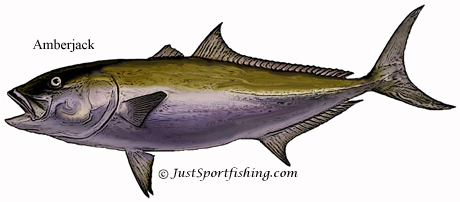|
|

How
to fish for Amberjack
If you are looking for the fish with a reputation as a battler, it is the greater Amberjack. Amberjacks are extremely powerful fish and require tough gear and tackle. A good place to start targeting the Amberjack is in 100 to 150 feet of water above wrecks, salt domes, and bottom breaks like cliffs or ledges, and they love to concentrate around oil and gas rigs or other towers. These deep-water structure-oriented fish seem to mostly cruise in the mid-depths, and once hooked get ready for a fight.
For Amberjacks a sliding sinker rig can be rigged. First, slip an egg sinker ranging anywhere from 8 to 16 ounces onto the main line and then tie on a dull-finish No. 1 swivel. Next add four to five feet of 90 to 130 pound-test fluorocarbon leader material and finish off with a 9/0 to 11/0 circle hook.
In order to deter the smallest fish in the school from striking first, go with the biggest bait possible. An Amberjack weighing 40 pounds or better does not have any problem engulfing a 2 to 4 pound baitfish. A top producing baitfish for Amberjacks is blue runner, other baits that will work are croakers, spots, pinfish, grunts and mullet or squid.
Although the use of live bait is extremely effective on Amberjacks, there are a number of large heavyweight jigs that these fish will also take. Thus, it is always wise to keep a number of proven amberjack jigs in your fishing tackle arsenal. An assortment of these in 7 to 10 ounce weights in colors like silver, chrome, white, chartreuse or combinations of these hues works well.
When fishing a jig put the reel in free spool and drop the lure down to or near the bottom. Once the jig is at the bottom retrieve the lure upwards with a swift lifting and then lowering motion of the rod tip. When you lower the rod tip crank up the slack extremely fast. Repeat this nonstop motion all the way up to the surface, then repeat the procedure. Unlike the more subtle downward pull of a bite on live bait, the strike on the jig can be abrupt and forceful, followed by a downward plunge of the rod tip.

|
JustSportfishing.com

|


